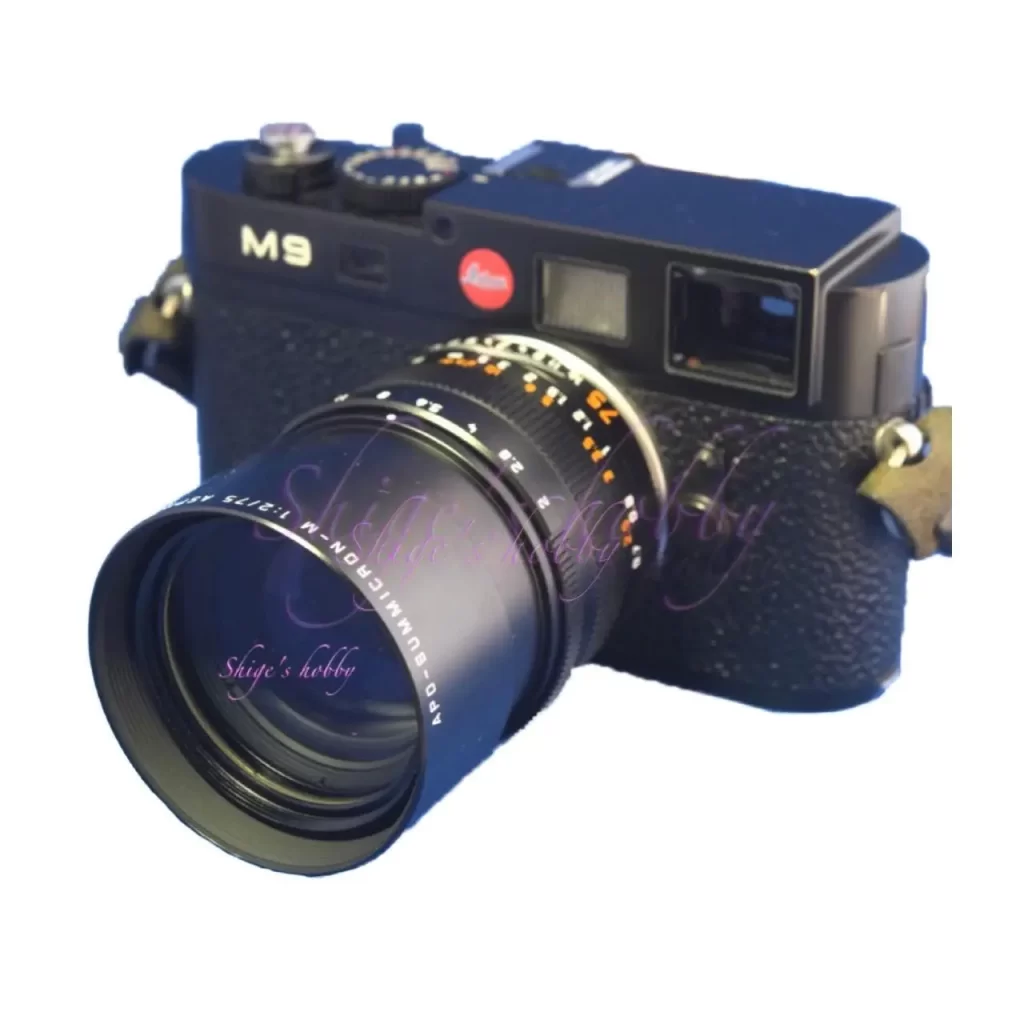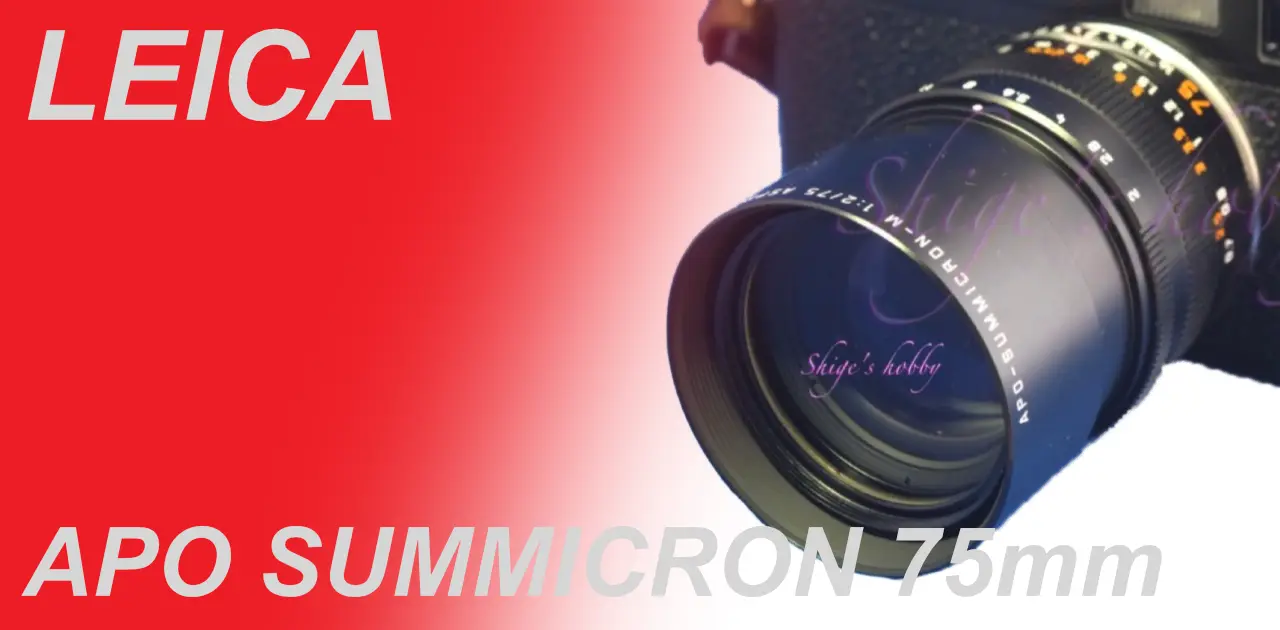Last updated on 2025-10-26
Mid-range telephoto lenses are being reevaluated
A review and Photo example of the APO Summicron M 75mm F2 ASPH..
Table of contents
Gallery
- LEICA APO-SUMMICRON-M 75mm F2 ASPH. Photo Example(with Leica M9P)
Review

1.Overview
The APO-Summicron-M 75mm ASPH. is a Leica M-mount medium telephoto lens with a focal length of 75mm and aspherical lenses.
It was released in 2004 and is still on sale as of 2024.
The style conforms to the standard of modern M Leica lenses released in the 2000s, with a built-in hood and “Leitz-Norm” font. The lens name is printed on the front of the hood, not on the front of the lens.
The minimum focusing distance is 0.7m and is linked to the rangefinder of Leica M cameras. The lens filter is E49 (49mm), a small diameter for a Leica medium telephoto lens and a diameter that is rarely used in other lenses.
Lenses with a newer manufacturing year have a 6-bit lens recognition code added as standard, and lenses without a code can have a code added for a fee through customer support.
2.Usage
It has good balance when attached to the Leica M9, a smooth helicoid, and a minimum shooting distance of 0.7m at a focal length of 75mm, so you need to place the subject a little far away, but it can just about be used for tabletop photography.
It has flawless depiction from wide open aperture, a good bokeh, and a decent yield when focusing through the M9’s viewfinder, so it’s a lens where you have to be careful to prevent camera shake rather than the focus position.
The aperture blades are not polygonal around F5.6, and have edges like a shuriken. Depending on the shooting scene, the shape of the bokeh can be a concern.
I attached it to the M9 and used it quite a few times, and although it is lighter and easier to handle than the Summilux 75mm, I realized that the focal length of 75mm is a bit cramped and doesn’t suit me, so I sold it.
3.Add Info
It is compact among Leica’s medium telephoto lenses, and compared to the Summilux 75mm with the same focal length, it weighs 130g and is about 1cm shorter in overall length.
I haven’t been able to explain it theoretically, but as I felt with the Summilux, 75mm and 80mm are focal lengths that seem similar but have an exquisitely different feeling.
The Summilux is heavy on the lens side and does not balance well when shooting, so I think it would look good with a large mirrorless camera like the LEICA SL typ601. If you use a LEICA SL, it is more straightforward to use the R-mount Summilux 80mm or the genuine LEICA SL APO Summicron 75mm.
For the 75mm focal length, I used the Voigtlander Color Heliar 75mm (L39 mount), the Summilux 75mm, and I also got an Apo-Summicron 75mm, but the usage rate of all three was not good, so I sold them. Voigtlander has been actively releasing lenses such as the Heliar Classic 75mm, Nokton 75mm, and Ultron 75mm, but after using three 75mm lenses including this one, it is clear that the utilization rate will not increase, so I have not purchased any of them.
The only 75mm class lens I have left is the Ms-optics SONNETAR 73mm F1.5.
Specification
| Items | SUMMICRON | SUMMILUX | SONNETAR | COLOR HELIAR |
| Manufacturer | LEICA | LEICA | Ms-optics | Voigtlander |
| focal length(mm) | 75 | 75 | 73 | 75 |
| Max aperture | 2 | 1.4 | 1.5 | 2.4 |
| Min aperture | 16 | 16 | 16 | 16 |
| Aperture blade | 10 | 10 | 12 | 10 |
| Lens Construction | 7elements in 5groups | 7elements in 5groups | 7elements in 5groups | 6elements in 5groups |
| Min distance(m) | 0.7 | 0.7 | 1.0 | 1.0 |
| Lens length(mm) | 66.8 | 80 | 57 | 64.5 (Include hood) |
| Lens Max diameter(mm) | 58 | 69 | 50 | 55.5 |
| Filter Size(mm) | 49 | 60 | 49 | 43 |
| Lens mount | M | M | M | L39 |
| Weight(g) | 430 | 560 | 197 | 230 |
| Production numbers | 1653+(Y 2005) *1 | 14,752 *1 | 400 | ? |
| Release date | 2004 | 1980 | 2018 | 1999 |
| Price(Yen/No-tax) | ¥660,000- | ¥400,000- 2024 2000s: ¥300,000 | ¥100,000- | ¥50,000(銀) ¥53,000(黒) |
Reference links
Update history
- 2024.12.13
- 2024.02.20:Update article
- 2022.05.06:First draft
Affiliate links
- Please see the disclaimer regarding advertising here.
- Italicized links in the text are advertisement links that take you to other sites.

Amazon Prime Sale



Be First to Comment